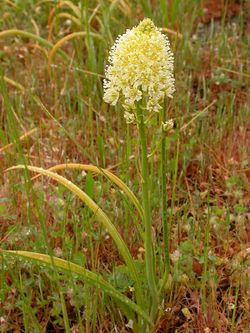Toxicoscordion venenosum
- Scientific Name: Toxicoscordion venenosum var. venenosum
- Family: Melanthiaceae
- Common Names: death camas, meadow death camas, common death camas, deadly zigadenus.
- Synonyms and Misapplications: Zigadenus venenosus
- Codon: TOXVEN
Contents
Taxonomy
| Scientific classification | |
|---|---|
| Kingdom: | Plantae |
| Subkingdom: | Viridiplantae |
| Phylum: | Tracheophyta |
| Subphylum: | Spermatophytina |
| Class: | Liliopsida |
| Subclass: | Lilidae |
| Order: | Liales |
| Family: | Melanthiaceae |
| Genus: | Toxicoscordion Rydb. |
| Species: | Toxicoscordion venenosum (S. Watson) Rydb. |
| Synonyms | |
| |
Description
Native, perennial herb growing from a layered bulb with a raceme of white and cream flowers, 20 to 50 cm tall.[2] Stems simple,[3] glabrous.[4] Leaves basally concentrated, linear, keeled, to 30 cm long; reduced cauline leaves above.[3] Flowers perfect, perianth subrotate, tepals 6, often short-clawed; stamens 6, longer or equal to the tepals; pistil with 3 styles, ovary superior, 3-locular,[5] becoming a capsule, 8-15 mm long.[3]
Bloom Period
April-July[3]
Distribution
British Columbia to Baja California, east to the Dakotas; var. venenosum more common west of the Cascades in Washington, var. graminaeum common in Eastern WA.[5]
Habitat
Coastal bluffs and prairies, grassy hillsides, and moist areas of shrub-steppe and open pine woodlands[5]
Uses
Medicinal Uses
Traditionally used as a violent emetic, sometimes mixed with blue flag; poultice of mashed roots applied to rheumatism, boils, bruises, sprains, sore legs, burns, swellings, rattlesnake bites, and broken bones to speed healing; mashed roots sometimes used as an arrow poison.[6]
Photo Gallery
References
- ↑ Integrated Taxonomic Information System. Retrieved from https://www.itis.gov/servlet/SingleRpt/SingleRpt?search_topic=TSN&search_value=522732#null
- ↑ Bowcutt, F., & Hamman, S. (2016). Vascular Plants of the South Sound Prairies. Olympia: The Evergreen State College Press. p. 120.
- ↑ 3.0 3.1 3.2 3.3 WTU Herbarium, Burke Museum, & University of Washington. Retrieved from https://biology.burke.washington.edu/herbarium/imagecollection/taxon.php?Taxon=Toxicoscordion%20venenosum%20var.%20venenosum
- ↑ Jepson Herbarium Online Flora. Retrieved from https://ucjeps.berkeley.edu/eflora/eflora_display.php?tid=108033
- ↑ 5.0 5.1 5.2 Hitchcock, C. L., Cronquist, A., Giblin, D., & Legler, B. et al. (2018). Flora of the Pacific Northwest: an illustrated manual. Seattle: University of Washington Press
- ↑ Native American Ethnobotany Database. Retrieved from http://naeb.brit.org/




